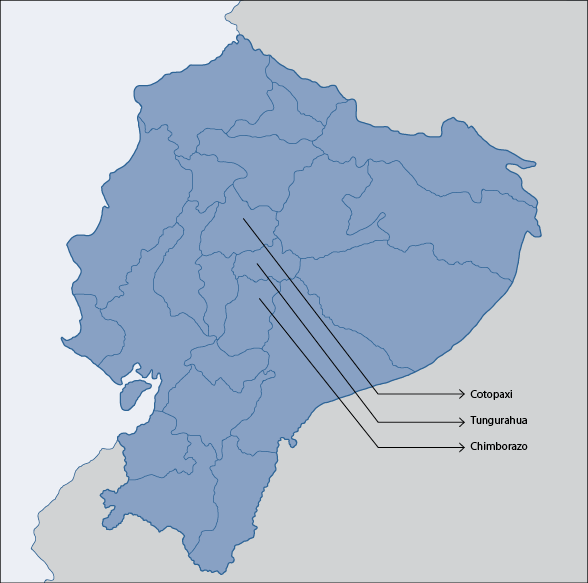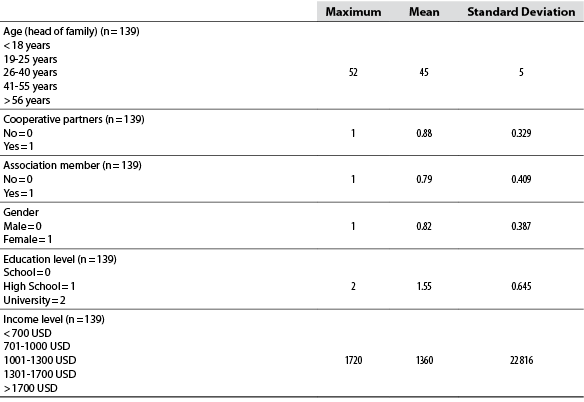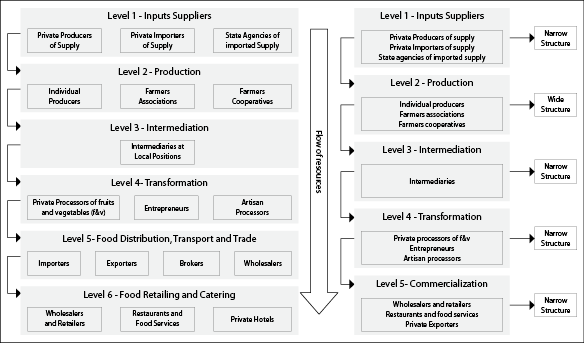Services on Demand
Journal
Article
Indicators
-
 Cited by SciELO
Cited by SciELO -
 Access statistics
Access statistics
Related links
-
 Cited by Google
Cited by Google -
 Similars in
SciELO
Similars in
SciELO -
 Similars in Google
Similars in Google
Share
Ciencia y Tecnología Agropecuaria
Print version ISSN 0122-8706On-line version ISSN 2500-5308
Cienc. Tecnol. Agropecuaria vol.21 no.2 Mosquera May/Aug 2020 Epub Mar 30, 2020
https://doi.org/10.21930/rcta.vol21_num2_art:1304
Economy and rural development
Analysis of the social, productive and governance dimensions of the Physalis peruviana chain: a case study of the Inter-Andean zone in Ecuador
1Wageningen University and Research. Wageningen, Países Bajos.
2Wageningen University and Research. Wageningen, Países Bajos.
3Universidad Técnica de Ambato. Ambato, Ecuador.
4Universidad Técnica de Ambato. Ambato, Ecuador.
5Universidad Técnica de Ambato. Ambato, Ecuador.
6Alta Scuola di Management ed Economia Agroalimentare. Cremona, Italia.
The diversification of agri-food products through emerging chains has a fundamental socio-economic role in Ecuador. However, a substantial amount of research has focused solely on examining agronomic yield. Conversely, there is a shift in the agri-food chain perspective to more sustainable production and consumption models. Socio-economic sustainability, chain configuration, and governance are aspects that can be improved. In this sense, socio-economic and productive factors are consequential with the level of development and still affect chain development. This study aimed to analyze social and production aspects to understand the dynamics of the Inca berry chain. Thus, vertical and horizontal dimensioning was introduced to contribute with relevant insights. The framework applied includes a revision of primary and support activities and high and low relevance flows. The research clustered pre-production, production, and post-production levels mapping the food chain, and identifying its actors. Results show several viable long-term strategies, such as marketing channel diversification, the intervention of academic institutions, and the empowerment of associations aimed towards circular economic models. The main contribution is the application of the chain configuration to assess performance. Based on the results obtained, our recommendation is to incorporate new indicators to analyze the environmental and institutional components in-depth. Both production unit professionals and academics may find this study useful to operationalize sustainability in agri-food chains.
Keywords associative structures; crop performance; dimensioning; Peruvian groundcherry; rural development
La diversificación de los productos agroalimentarios mediante cadenas emergentes juega un papel socioeconómico fundamental en Ecuador. Sin embargo, las investigaciones se han centrado solo en examinar el desempeño agronómico. Por otro lado, existe un cambio en la perspectiva hacia modelos de producción y consumo sostenibles. La sostenibilidad socioeconómica, la configuración de cadena y la gobernanza son aspectos para proponer mejoras. Los factores socioeconómicos y productivos son consecuentes con el nivel de desarrollo y aún afectan el progreso de las cadenas. Este estudio tuvo como objetivo analizar aspectos socioeconómicos y de producción para comprender la dinámica de la cadena de bayas incas, por lo cual se introdujo el dimensionamiento vertical y horizontal para contribuir con ideas relevantes. El marco aplicado cuenta con actividades primarias y de apoyo, y flujos de alta y baja relevancia. La investigación agrupó niveles de preproducción, producción y postproducción; además, se ejecutó el mapeo de la cadena alimentaria y la identificación de los actores. Los resultados obtenidos mostraron estrategias viables a largo plazo, como la diversificación de canales de comercialización, la intervención de instituciones académicas y el empoderamiento de las asociaciones, dirigidas a modelos circulares. La principal contribución es la aplicación de la configuración para evaluar el rendimiento. Además, recomendamos emplear nuevos indicadores para analizar los componentes ambientales e institucionales a profundidad. Los profesionales con unidades de producción y académicos pueden encontrar útil el estudio para poner en funcionamiento la sostenibilidad agroalimentaria.
Palabras clave desarrollo rural; desempeño de cultivos; dimensionamiento; estructuras asociativas; uchuva
Introduction
In the last decade, crop export growth has been significant in Latin American countries (Franko, 2018). These exports are mainly of fresh products, such as flowers, fruits, vegetables, and cereals (Central Bank of Ecuador, 2018). The Governments of these countries claim that trade activity has increased because of the growing food demand of developed countries (Reardon, 2015; Streeten, 2016). This aspect evidences relevant changes in consumers’ diet and, therefore, in commercial opportunities for Latin American agri-food actors (Augustin et al., 2016). Currently, most of the Latin American countries have implemented policies promoting export fruits and vegetables (Furtado, 2018). Further, the Inter-American Development Bank (IDB), is a “pivotal player” in strengthening foreign trade with Latin America (IDB, 2018). However, medium and long-term adjustments will establish the economic positioning of this sector over time.
Previous research has pointed out some socio-economic issues of the Latin American fruit and vegetable sector (Phukan et al., 2017). The consequences of agro-export growth, and the high incidence of informal recruitment of workers are examples of such issues (Martínez Valle, 2016). Moreover, as in the case of the Peruvian groundcherry (Physalis spp.) chain in Ecuador, the persistence of minimal profit margins for farmers (Thiele et al., 2011), and the vulnerability of peasant families (Alvarado & Rebaï, 2018; Barrera-Mosquera et al., 2010; Hallam et al., 2004) are some concerns evidenced. Researchers claim that food chains that fail to adopt strategies tend to suffer a severe downturn (Sands & Ferraro, 2010; Sellahewa & Martindale, 2010).
The progress of the Ecuadorian agri-food chains also suffers from market failures and a low level of collaboration (Notarnicola et al., 2012; Romero & Wollni 2019). For example, emerging chains such as the one of the Peruvian groundcherry shows odds related to the control imposed by large companies in the supply chains (Ruiz, 2018; Vega-Quezada et al., 2017), and the coordination level between actors (Central Bank of Ecuador, 2018; Observatory of Economic Complexity [OEC], 2017; Ministry of Agriculture of Ecuador, 2014; Romero and Wollni, 2018). Therefore, the scientific community should consider the aspects mentioned above when assessing the performance of fruit and vegetable supply chains.
The Peruvian groundcherry network is an emerging chain located in the highland region of Ecuador, which is characterized by the expansion of its production units in the last years (Senplades, 2015). This chain employs around 2000 rural workers who participate in activities such as soil conditioning, transport, and the transformation of raw material (Romero & Wollni, 2018). Also, 98 % of the companies involved are small and medium-sized enterprises (SMEs) (Sarango-Lalangui et al., 2018), which look for an opportunity to be positioned in a higher-level market. Considering the abovementioned, this paper presents an attempt to evaluate the Peruvian groundcherry chain, including its primary and support activities comprehensively. Besides, a horizontal and vertical configuration will be performed to understand the implications of potential actors’ collaboration. Both practitioners in production units and academics might find the study useful, as it offers sustainability operationalization research in agri-food chains. Therefore, the paper is structured as follows: Section 2 explains the materials and methods employed to implement the study, and the results and discussion are presented in section 3; section 4 shows some conclusions and research implications.
Materials and methods
The data collection took place in the inter-Andean zone of Ecuador, comprising the provinces of Cotopaxi, Tungurahua, and Chimborazo (figure 1). The Peruvian groundcherry chain has received attention from different sectors because of its farming structure, inequality in irrigation water, loss of the páramo ecosystem, and market price instability. The methodology involved socio-economic, production, export, and agricultural policies. Moreover, it highlighted the structures at the horizontal and vertical levels, as explained below:
1. Food chain mapping. The scheme employed is the one developed by Hawkes & Ruel (2011), which determined the groups of actors and relevant activities. Moreover, this step identified the less and higher importance flows running through the chain.
2. Identification of value chain actors. This phase employed the information from the last census (2015) conducted by the Ministry of Agriculture (MAG) (table 1). Besides, it analyzed the post-production actors by examining the records submitted by the Ministry of Industries and Productivity (Mipro, 2016) (table 2) regarding SMEs and large companies.
Table 2 Small and medium-sized enterprises and large companies involved in the Peruvian groundcherry chain per province

Source: National Secretariat of Development (Senplades) (2017)
3. Sample size description. The experiment used the continuous variable “number of producers registered by MAG” to estimate the sample size of producers. Also, it applied the Sukhatme formula (Sukhatme, 1957) at the 95 % confidence level. The sample of producers assessed 41, 53, and 45 producers from Cotopaxi, Tungurahua, and Chimborazo, respectively.
4. Descriptive analysis. Previously, the experimental phase carried out a workshop with stakeholders to select performance variables from a pre-established list. The list considered productive and socio-economic factors. Besides, it accounted for export and agricultural policy implications. Then, it constructed interviews and surveys, and Cronbach’s alpha index was employed to validate the answers to the posed questions. Furthermore, it analyzed the collected data through descriptive tools, such as the Contribution Analysis and the Dominance Analysis (Azen & Budescu, 2003; Budescu, 1993; Mayne, 2008; Triantaphyllou & Mann, 1994).
5. Scanning the configuration. In this step, the experiment applied the estimating outline published by Gereffi and Fernandez-Stark (2016) to identify the horizontal and vertical structures. This tool gave vital insights on the complexity level of the studied chain.
Results and discussion
Food chain mapping
The overview started by identifying support activities (figure 2). The Ecuadorian Agency of Plant Protection (Agrocalidad), and Instituto Nacional de Investigaciones Agropecuarias [National Institute of Agricultural Research] (Iniap), performed 60 % of the operations up to this stage. Examples of those operations are explained below. Seventy-five percent of the public and private financing entities supported production and post-production activities through funding programs for SMEs, entrepreneurs, and peasant producers.
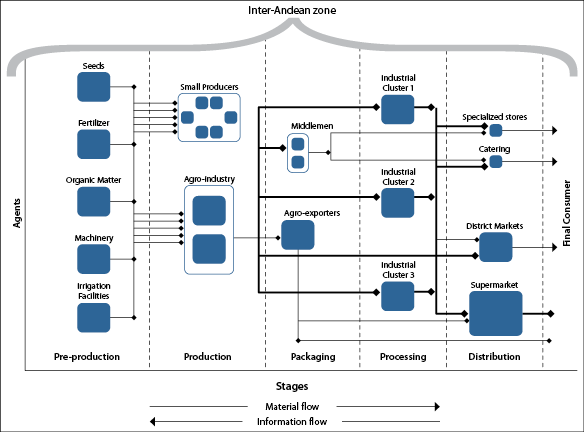
Source: Elaborated by the authors
Figure 2 Actors and flows identified in the Peruvian groundcherry agri-food chain
Furthermore, the chain mapping identified the production stage, which included individual producers and two associations. These actors started with higher importance flows (agri-food material) by delivering them at commercialization centers. Examples of those commercialization centers were wholesale outlets located in the cities of Ambato and Riobamba. Then, private processors and startups were identified, which transformed raw material into goods with high value-added. More than 50 % of the processed Peruvian groundcherry belonged to the canning and dried fruit categories.
Processing actors also traded their business portfolio to big retailing corporations because of the potential opportunity to consolidate brands. Furthermore, the mapping recognized actors involved in the commercialization stage. Such actors were importers, exporters, retailers, and advertising agencies, among others. For instance, Corporación La Favorita S.A. and Corporación El Rosado S.A. were retailers with high national participation in the Peruvian groundcherry market. This general overview will be detailed in the descriptive analysis section.
Identification of value chain actors
The Ministry of Agriculture of Ecuador (2016) pointed out that 0.95 % of the fruits and vegetable producers are involved in the Peruvian groundcherry production stage. The province with the largest Peruvian groundcherry production surface was Tungurahua. On the other hand, the Secretariat of Planning and Development (2017) reported that 7,112 companies have commercial operations that include Peruvian groundcherry. Tungurahua registered 52.53 % of the companies, Chimborazo accounted for 25.73 %, and Cotopaxi recorded 21.73 %.
Descriptive analysis
Pre-production stage
The outcomes stated that the National Government prioritized strategies, such as the development of the rural economy and the redistribution of production supplies, including manuals, seeds, fertilizers, and irrigation systems, among others. Besides, public agencies were responsible for transferring novel techniques at the production level (Houtart, 2014; Santacoloma-Varón, 2015). Also, academic institutions such as the Technical University of Ambato and University of the Armed Forces led programs aimed at improving production yield, plant genetics, and processing technology. The scientific community of those institutions devoted many resources to topics such as land and water use efficiency and food packaging (Mutebi Kalibwani et al., 2018; Rodríguez Moreno, 2018).
Production stage
Socio-economic findings. The outcomes showed that producers were between 29 and 52 years old. Most of them were men (58 %), the prevalent education level was up to middle school (39 %), and 27 % of the respondents finished the bachelor. This academic background situation was not a barrier to negotiate with downward actors. However, farmers always took the risk concerning contract renewal with buyers and fair selling prices in each business cycle. Additionally, 37 % of the producers were cooperative partners, and 30 % were association members; even so, few of them were willing to adopt specific strategies to expand the volumes of Peruvian groundcherry. The last breakthrough was that 58 % of the producers financed the production through savings, and 38 percent acquired bank debts (table 3).
Regarding production results, most of the producers (60 %) considered the growing demand for Peruvian groundcherry at the local and international levels as the primary driver to expand crops. The current worldwide trade opportunity was an immersive interest for those who were cultivating Peruvian groundcherry. The most promising segment was the European market. However, the results also pointed out that 55 % of the respondents had more than 3 ha of land, but the Peruvian groundcherry crops covered only between 0.1 and 0.9 ha on average. Another driver of Peruvian groundcherry supply was the high fragmentation of traditional markets, such as potato, maize, and onion. However, findings determined a production stage with limited downward coordination, where 42 % of the producers showed high crop diversification, and just 31 % operated through partnerships. Besides, there was a low density of Colombian and Kenyan genotypes (figure 3). These foreign varieties showed phytopathological vulnerability and lack of adaption to Ecuadorian field conditions (Arellano, 2018; Galvis et al., 2015). The Ecuadorian genotype was by far the most common variety in production units. According to Brito (2015) and Carrillo-Perdomo et al. (2015), in Ecuador, there were approximately 20 types of Peruvian groundcherry with prominent sensorial features, such as color, size, and shape.
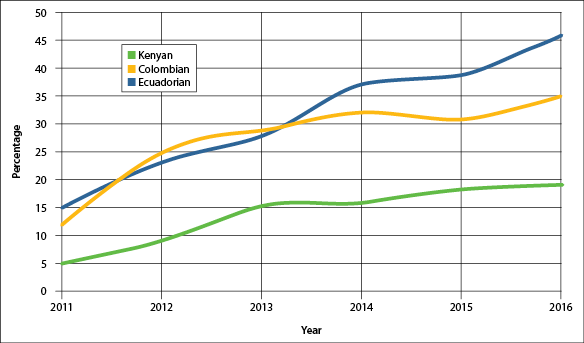
Source: Elaborated by the authors, based on Ministerio de Agricultura (2014, 2016)
Figure 3 Peruvian groundcherry genotypes cultivated in Ecuador from the years 2011 to 2016
The persistence of knowledge gaps affected Peruvian groundcherry producers and all the value chain directly and indirectly. According to The National Institute of Agricultural Research (Iniap) (2016), these gaps included sustainable Peruvian groundcherry crop management and plant breeding, due to the lack of private investment and governmental incentives. Therefore, the National Plan for Agricultural Support 2013-2017 failed in supporting key aspects of emerging agri-food chains. The design of this policy aimed at enabling accessibility to agronomic assets (Brito, 2015). However, it was necessary to implement a monitoring plan for those policies, which was able to reinforce the agricultural systems.
Apart from that, observations elucidated some productivity rates. An average of 12.9 t/ha of Peruvian groundcherry yield was observed considering these means (figure 4). The reference was Colombia as the current leader in Peruvian groundcherry production. The results reported by Carrillo-Perdomo et al. (2015) and Fischer et al. (2014) on Colombian yields reported 14.5 t/ha. The production systems and infrastructure of both countries were very similar and competitive compared with each other. However, returns could vary depending on the production method. In open field, yields ranged between 10 and 13 t/ha, whereas greenhouse systems yielded between 15 and 25 t/ha. Further, findings indicated that most likely, the challenges were found at the post-harvest practices where only 35 % of the producers applied them to reduce losses.
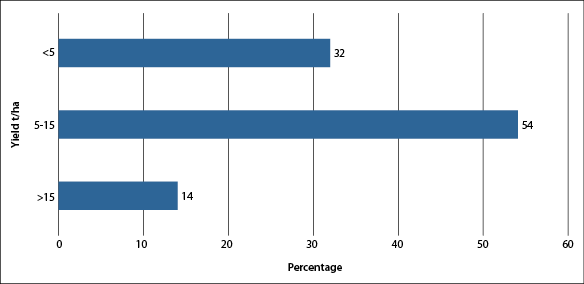
Source: Elaborated by the authors
Figure 4 Productive yield (t/ha) of the Peruvian groundcherry agri-food chain
Regarding the performance findings, respondents stated a gross farming profit of USD 11 500/year (±150 USD/year) and a net income of USD 6600/ha/year (±50 USD/year). The outcomes reported by Orjuela Castro et al. (2017) pointed out a Colombian gross profit between USD 5000/ha/year and 8000/ha/year during 2014 and 2015. According to Altamirano (2010), Peruvian groundcherry production was profitable, and its internal rate of return (IRR) on investment ranged between 13 and 25 percent. Furthermore, MAG (2016) reported an 18 percent profitability rate in the Peruvian groundcherry production, and the sum of fix and variable costs to produce one hectare of Peruvian groundcherry is USD 6000 in the initial year. The predicted yields under the right climatic conditions were around 13 000 kg/ha/year, and with a price of USD 1.00/kg, each hectare would generate a gross income of USD 13 000/year. Then, by subtracting the production cost, a gross profit of USD 7000/year would be obtained. Therefore, the observations established a contribution margin of around USD 0.46/kg.
Post-production stage: processing companies
Economic findings. The outcomes showed that 98.43 % were SMEs, and 1.57 % were large companies. Also, 40.10 % were raw material processors, whereas 60.90 % combined the processing with marketing activities. Besides, 69.20 % of the companies worked with retailers, and only 10.40 % were exporting companies. However, respondents mentioned that processing companies required support to improve their performance. Such support would be to aid the diversification of their product portfolio and the possibility of building links with public entities to expand the foreign trade (Proecuador, 2016; 2017). Besides, 45 % of the respondents considered the supply price as the decisive factor during the purchasing process of Peruvian groundcherry. However, the quality criteria were relevant. For instance, low-quality fruit dropped the chance of negotiation up to a 49 % probability. This was not the case of the demand price, where 57 % of the respondents claimed that customer requirement was the primary driver (figure 5).
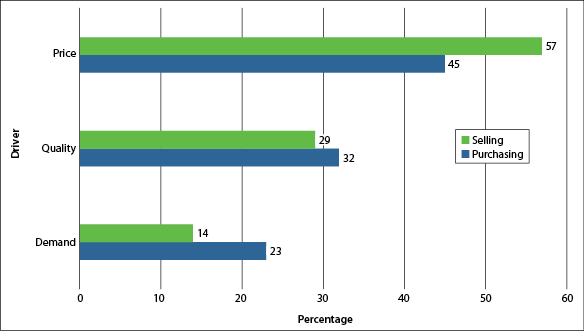
Source: Elaborated by the authors
Figure 5 Influencing factors in purchasing and selling Peruvian groundcherry by processors
In fulfilment to logistical findings, the results pointed out that only 39.10 % of the companies owned transport facilities, whereas 60.90 % outsourced this service through local van and truck cooperatives. Only 40 % of the companies did not show difficulties in transporting fresh Peruvian groundcherry. Furthermore, 89 % of the companies’ delegates emphasized the high dependency they had on the deliveries carried out for producers; thus, there was not a competition between both stages. Their suppliers were middlemen (48 %) and full-time farmers (52 %). Despite the challenges faced with the logistics, it is noteworthy to emphasize the public investment in roads aimed at improving efficiency. Nevertheless, the enhancement of short marketing circuits by following trends in customer preferences (figure 6), could reach more sustainable logistics.
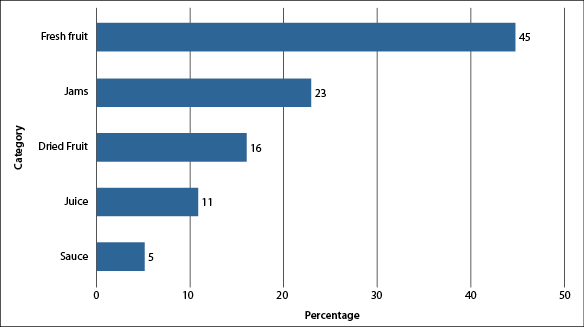
Source: Elaborated by the authors
Figure 6 Categories of Peruvian groundcherry-based products preferred by consumers
The transition in the commercialization of Peruvian groundcherry in fresh and processed formats was remarkable. It had quickly spread through local and district markets. However, it was worth noting that the Peruvian groundcherry chain needed mechanisms to coordinate the flow of goods efficiently by accounting social, economic, and environmental aspects jointly. The following section explains the performance and role of formal distributors and their impact on the functioning of the chain.
Post-production: distributors
In fulfilment to economic findings, the outcomes from the Market Power Control Agency [Superintendencia de Control de Poder del Mercado] (SCPM) showed a highly concentrated retailing structure (figure 7). The Herfindahl-Hirschman Index (HHI) presented values higher than 2,500 during the last 15 years. Besides, they stated that corporations managed the food distribution businesses and invested intensively to expand their marketing chains. The power of these actors was imminent. Respondents said that distributors financed activities with capital and bank lending (65 %), while 35 percent used the stock exchange to involve new investors. Also, they argued that each distributor set up a differentiation strategy to prevent the entry of foreign retailers and procedures to avoid affectations of final consumer pricing. The price of fresh fruit ranged between USD 2.00 to 3.00/kg, whereas the processed one ranged between USD 6.00 to 9.00/kg. However, the pricing also depended on the profit margins predetermined by the board of directors.
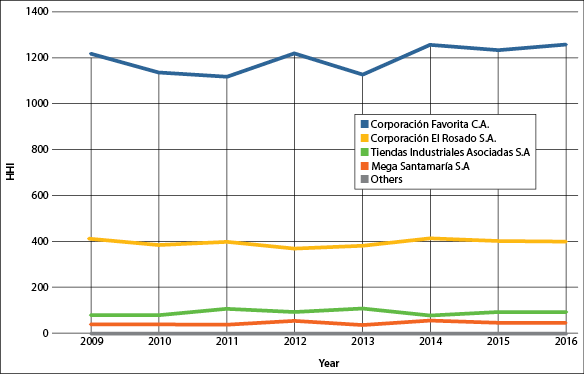
Source: Superintendencia de Control de Poder de Mercado (SCPM) (2017)
Figure 7 The Herfindahl-Hirschman Index for the retailing sector in Ecuador from 2008 to 2016
In fulfilment to logistic findings, the outcomes stated that 80 % of the companies owned a truck fleet, whereas 20 % outsourced this service through regional truck cooperatives. Also, 90 % of the companies depended on the deliveries of Peruvian groundcherry products from producers and processors. However, they considered the fruit farming intention in long term perspective. Besides, 78 % of their suppliers were SMEs, and 22 % were full-time farmers. Interviewees claimed the strict policies they had to negotiate directly with formal companies.
Foreign trade
Findings stated that Peruvian groundcherry exports presented a growing trend of volumes with a rate of 13 % per year since 2000. Exporter companies and SMEs faced rigorous revisions because of international market regulations (Castro-Gonzáles et al., 2015). Further, authorities supported good agricultural practices to increase competitiveness. However, respondents claimed that 40 % of the exporters faced losses at some point in the trading process. The main competitors of Ecuador were Colombia, Zimbabwe, Kenya, and Peru (Espinoza & Monteros, 2016; Iizuka & Gebreeyesus, 2017).
Scanning the configuration
Horizontal configuration. The initial level was responsible for the provision of inputs. The second one received more than 60 % of the contributions from Level 1. Observations pointed out that the success of the Peruvian groundcherry chain depends on the associative structures. Level 3 served as an intermediary between the production and processing stages and channeled off 36 % of the production. Level 4 included different size processors. Level 5 distributed products to local or international markets and also to consumers. Level 6 is responsible for retail delivery, food services, and hotels (figure 8). They had direct connections with consumers and had access to updated information on consumer trends.
Vertical configuration. The outcomes examined the degree of fragmentation and the distribution of negotiation power. The fragmented level was the second, which is comprised of farmers, producers, associations, and agricultural cooperatives, and its negotiation power was constrained. Levels corresponding to input suppliers, processors, intermediaries, and distributors were small structures. Their negotiation power and capability to differentiate goods were higher (figure 8). These factors were significant when the market competition took place.
Conclusions
The main actors identified are public entities. The priority of these actors was to strengthen peasant family sustainability. Therefore, the first strategy was to reinforce these entities, which provided technical training and monitoring of Peruvian groundcherry cultivation through extension programs. The second potential strategy was the stimulation of associativity at the producers’ level. This strategy could contemplate a market orientation so that producers will capture a better national and international market positioning. The third strategy pointed to the generation of links with academic institutions to improve performance, efficiency, sustainable management, among other relevant aspects. The fruit and vegetable market was very competitive, dynamic, and profitable. Therefore, the chain under study required focal actors (companies) that promote possible horizontal and vertical synergies between the stages. This strategy suggested studies that deepen collaborative behavior and coordination mechanisms. Finally, the investigation presented limitations in the performance estimations. Thus, we recommend incorporating new indicators to analyze sustainability integrally through environmental and institutional dimensions that lead towards the implementation of circular chain models.
Acknowledgments
The authors acknowledge the support from the researchers of Alta Scuola di Management ed Economia Agro-alimentare - SMEA, Università Cattolica del Sacro Cuore, and the owners of Industria de Procesados Hortofrutícolas del Ecuador (Inphec Agroindustrial).
REFERENCES
Alvarado Vélez, J. A., & Rebaï, N. (2018). Mining and vulnerability of rural territories in the Ecuadorian Andes: evidence from the province of Azuay. Cuadernos de Geografía-Revista Colombiana de Geografía, 27(2), 389-406. http://dx.doi.org/10.15446/rcdg.v27n2.66062 [ Links ]
Altamirano, M. (2010). Estudio de la cadena productiva de uvilla (Physalis peruviana L.) en la Sierra norte del Ecuador [Tesis de pregrado, Universidad San Francisco de Quito]. Repositorio de Tesis de Grado y Posgrado USFQ. http://repositorio.usfq.edu.ec/bitstream/23000/950/1/95220.pdf [ Links ]
Arellano, M. J. (2018). Detección de Fusarium oxysporum en cultivos de uvilla (Physalis peruviana L.) en la Sierra norte y centro del Ecuador [Tesis de grado, Pontificia Universidad Católica del Ecuador]. Repositorio de Tesis de Grado y Posgrado PUCE. http://repositorio.puce.edu.ec/handle/22000/14683 [ Links ]
Augustin, M. A., Riley, M., Stockmann, R., Bennett, L., Kahl, A., Lockett, T., Osmond, M., Sanguansri, P., Stonehouse, W., Zajac, I., & Cobiac, L. (2016). Role of food processing in food and nutrition security. Trends in Food Science & Technology, 56(11), 115-125. https://doi.org/10.1016/j.tifs.2016.08.005 [ Links ]
Azen, R., & Budescu, D. V. (2003). The dominance analysis approach for comparing predictors in multiple regression. Psychological Methods, 8(2), 129-148. https://doi.org/10.1037/1082-989x.8.2.129 [ Links ]
Banco Central del Ecuador. (2018). Monthly Statistical Information. https://www.bce.fin.ec/en/index.php/economic-information [ Links ]
Banco Interamericano de Desarrollo (BID). (2018, 28 de marzo). Seven Latin American countries will receive support from IDB Invest and LAAD to strengthen agriculture. IDB News. https://www.iadb.org/en/news/seven-latin-american-countries-will-receive-support-idb-invest-and-laad-strengthen-agriculture [ Links ]
Barrera-Mosquera, V., De los Rios-Carmenado, I., Cruz-Collaguazo, E., & Coronel-Becerra, J. (2010). Analysis of available capitals in agricultural systems in rural communities: the case of Saraguro, Ecuador. Spanish Journal of Agricultural Research, 8(4), 1191-1207. https://doi.org/10.5424/sjar/2010084-1408 [ Links ]
Brito, M. (2015). Impulsar un cultivo de alto potencial para mejorar las condiciones de vida de los cultivadores. Food Chain Partnership. https://bit.ly/2IvXePA [ Links ]
Carrillo-Perdomo, E., Aller, A., Cruz-Quintana, S. M., Giampieri, F., & Alvarez-Suarez, J. M. (2015). Andean berries from Ecuador: A review on botany, agronomy, chemistry and health potential. Journal of Berry Research, 5(2), 49-69. https://doi.org/10.3233/JBR-140093 [ Links ]
Castro-Gonzáles, S., Vázquez-Guzmán, E., & Vega Vilca, J. C. (2015). Ecuador, Perú y Colombia: ¿Competidores o complementarios Sudamericanos? Análisis de su competitividad global. Revista Global de Negocios, 3(6), 13-28. [ Links ]
Espinoza, K. V., & Monteros. M. A. (2016). Persistencia campesina en el Ecuador: Vulnerabilidades socio-económicas y ambientales y acciones colectivas para enfrentarlas [Tesis de pregrado, Escuela Politécnica Nacional]. BIBDigital. https://bibdigital.epn.edu.ec/bitstream/15000/16571/1/CD-7231.pdf [ Links ]
Fischer, G., Almanza-Merchán, P. J., & Miranda, D. (2014). Importancia y cultivo de la uchuva (Physalis peruviana L.). Revista Brasileira de Fruticultura, 36(1), 01-15. https://doi.org/10.1590/0100-2945-441/13 [ Links ]
Franko, P. (2018). The puzzle of Latin American economic development. Rowman & Littlefield. [ Links ]
Furtado, C. (2018). Economic development of Latin America. En P. F. Klaren (Ed.), Promise of Development (pp. 124-148). Routledge. https://doi.org/10.4324/9780429497995-9 [ Links ]
Galvis, J. A., Fischer, G., & Gordillo, O. P. (2015). Cosecha y poscosecha de la uchuva. En G. Fischer (ed.), Avances en cultivo, poscosecha y exportación de la uchuva (Physalis peruviana L.) en Colombia (pp. 165-190). Universidad Nacional de Colombia. [ Links ]
Hallam, D., Liu, P., Lavers, G., Pilkauskas, P., Rapsomanikis, G., & Claro, J. (2004). The market for non-traditional agricultural exports. [Informe técnico N. 3]. FAO. http://www.fao.org/docrep/007/y5445e/y5445e00.HTM [ Links ]
Hawkes, C., & Ruel, M. (2011). Value chains for nutrition [documento de conferencia]. Conferencia Internacional IFPRI, Nueva Delhi, India. https://pdfs.semanticscholar.org/515f/6f63f0abac4ff95bcd2272c6b54acd253bac.pdf [ Links ]
Houtart, F. (2014). El desafío de la agricultura campesina para el Ecuador. En J. Cuvi (ed.), La restauración conservadora del correísmo (pp. 167-178). Arcoíris Producción Gráfica. [ Links ]
Iizuka, M., & Gebreeyesus, M. (2017). Using functions of innovation systems to understand the successful emergence of non-traditional agricultural export industries in developing countries: Cases from Ethiopia and Chile. The European Journal of Development Research, 29(2), 384-403. https://doi.org/10.1057/s41287-016-0004-0 [ Links ]
Instituto Nacional de Investigación Agrícola (Iniap). (2016). Caracterización morfoagronómica de la colección de uvilla (Physalis peruviana L.) del banco de germoplasma del Iniap, Ecuador. http://repositorio.iniap.gob.ec/handle/41000/530 [ Links ]
Martínez Valle, L. (2017). Agribusiness, peasant agriculture and labour markets: Ecuador in comparative perspective. Journal of Agrarian Change, 17(4), 680-693. https://doi.org/10.1111/joac.12188 [ Links ]
Mayne, J. (2008). Contribution analysis: An approach to exploring cause and effect. ILAC Brief. https://cgspace.cgiar.org/handle/10568/70124 [ Links ]
Ministerio de Agricultura de Ecuador. (2014). Zonificación agroecológica económica del cultivo de uvilla (Physalis peruviana L.). Zonificación agroecológica y económica en el Ecuador continental. Coordinación General del Sistema de información Nacional. [ Links ]
Ministerio de Agricultura de Ecuador. (2016). Zonificación agroecológica económica del cultivo de uvilla (Physalis peruviana L.). ZAE. [ Links ]
Ministerio de Industrias y Productividad Ecuador (Mipro). (2016). Política industrial del Ecuador 2016- 2025. Más industrias mayor desarrollo. http://www.competencias.gob.ec/wp-content/uploads/2017/06/06PPP2016-POLITICA02.pdf [ Links ]
Mutebi Kalibwani, R., Twebaze, J., Kamugisha, R., Kakuru, M., Sabiiti, M., Kugonza, I., & Nyamwaro, S. (2018). Multi-stakeholder partnerships in value chain development: A case of the organic pineapple in Ntungamo district, Western Uganda. Journal of Agribusiness in Developing and Emerging Economies, 8(1), 171-185. https://doi.org/10.1108/JADEE-08-2015-0038 [ Links ]
Notarnicola, B., Hayashi, K., Curran, M. A., & Huisingh, D. (2012). Progress in working towards a more sustainable agri-food industry. Journal of Cleaner Production, 28, 1-8. https://doi.org/10.1016/j.jclepro.2012.02.007 [ Links ]
Observatory of Economic Complexity (OEC). (2017). Exportaciones, importaciones, y socios comerciales. https://oec.world/es/profile/country/ecu/ [ Links ]
Orjuela-Castro, J. A., Morales-Aguilar, F. S., & Mejía-Flórez, L. F. (2017). Which is the best supply chain for perishable fruits, Lean or Agile? Revista Colombiana de Ciencias Hortícolas, 11(2), 294-305. https://doi.org/10.17584/rcch.2017v11i2.5950 [ Links ]
Phukan, P., Lepcha, B., Avasthe, R., & Singh, N. J. (2017). Socio-economic characteristics and constraints faced by Horticultural growers of East Sikkim. Journal of Krishi Vigyan, 6(1), 175-179. https://doi.org/10.5958/2349-4433.2017.00075.7 [ Links ]
Proecuador (2016). Boletín de inteligencia de mercados agosto-septiembre 2016. https://www.proecuador.gob.ec/category/descargas/boletin-de-inteligencia-de-mercados/ [ Links ]
Proecuador (2017). Boletín de comercio exterior 2017. https://www.proecuador.gob.ec/search/BOLETIN+COMERCIO+EXTERIOR/ [ Links ]
Reardon, T. (2015). The hidden middle: the quiet revolution in the midstream of agrifood value chains in developing countries. Oxford Review of Economic Policy, 31(1), 45-63. https://doi.org/10.1093/oxrep/grv011 [ Links ]
Rodríguez Moreno, J. A. (2018). Innovation behaviour and performance in Ecuadorian firms [Tesis de doctoral, Universidad de Valencia]. Roderic. http://hdl.handle.net/10550/66092 [ Links ]
Romero Granja, C., & Wollni, M. (2018). Dynamics of smallholder participation in horticultural export chains: evidence from Ecuador. Agricultural economics, 49(2), 225-235. https://doi.org/10.1111/agec.12411 [ Links ]
Romero Granja, C., & Wollni, M. (2019). Opportunistic behaviour and trust: experimental results from broccoli farmers in Ecuador. Journal of Agricultural Economics, 70(1), 62-80. https://doi.org/10.1111/1477-9552.12271 [ Links ]
Ruiz, M. (2018). Ejes centrales de acumulación de capital en el Ecuador actual: una panorámica general. Revista Economía, 70(111), 77-93. https://doi.org/10.29166/economia.v70i111.1391 [ Links ]
Sands, S. & Ferraro, C. (2010). Retailers’ strategic responses to economic downturn: insights from down under. International Journal of Retail & Distribution Management, 38(8), 567-577. https://doi.org/10.1108/09590551011057408 [ Links ]
Santacoloma-Varón, L. E. (2015). Importancia de la economía campesina en los contextos contemporáneos: una mirada al caso colombiano. Entramado, 11(2), 38-50. https://doi.org/10.18041/entramado.2015v11n2.22210 [ Links ]
Sarango-Lalangui, P., Álvarez-García, J., & del Río-Rama, M. (2018). Sustainable practices in small and medium-sized enterprises in Ecuador. Sustainability, 10(6), 2105. https://doi.org/10.3390/su10062105 [ Links ]
Sellahewa, J. N., & Martindale, W. (2010). The impact of food processing on the sustainability of the food supply chain. Aspects of Applied Biology, 102, 91-99. [ Links ]
Senplades. (2015). Zona 3 Centro Agenda Zonal. Secretaría Nacional de Planificación y Desarrollo. https://www.planificacion.gob.ec/wp-content/uploads/downloads/2015/11/Agenda-zona-3.pdf [ Links ]
Senplades. (2017). Agricultura familiar y comunicación para el desarrollo. https://www.planificacion.gob.ec/el-plan-nacional-para-el-desarrollo-2017-2021-impulsa-el-desarrollo-rural-integral/ [ Links ]
Streeten, P. (2016). What price food?: Agricultural price-policies in developing countries. Springer. [ Links ]
Sukhatme, P. (1957). Sampling theory of surveys with applications. The Indian Society of Agricultural Statistics; Iowa State College Press. https://archive.org/details/SamplingTheoryOfSurveysWithApplications/page/n2 [ Links ]
Superintendencia de Control de Poder de Mercado (SCPM). (2017). Sector minorista en Ecuador. https://www.scpm.gob.ec/sitio/wp-content/uploads/downloads/2019/01/Competencia-Innovacioon-Sector-Supermercados.pdf [ Links ]
Thiele, G., Devaux, A., Reinoso, I., Pico, H., Montesdeoca, F., Pumisacho, M., Andrade-Piedra, J., Velasco, C., Flores, P., Esprella, R., Thomann, A., Manrique, K., & Horton, D. (2011). Multi-stakeholder platforms for linking small farmers to value chains: evidence from the Andes. International Journal of Agricultural Sustainability, 9(3), 423-433. https://doi.org/10.1080/14735903.2011.589206 [ Links ]
Triantaphyllou, E., & Mann, S. (1994). Using the analytic hierarchy process for decision making in engineering applications: Some challenges. The International Journal of Industrial Engineering, 2(1), 35-44. [ Links ]
Vega Quezada, C., Blanco, M., & Romero, H. (2017). Synergies between agriculture and bioenergy in Latin American countries: A circular economy strategy for bioenergy production in Ecuador. New Biotechnology, 39, 81-89. https://doi.org/10.1016/j.nbt.2016.06.730 [ Links ]
Received: February 18, 2019; Accepted: November 27, 2019











 text in
text in 



